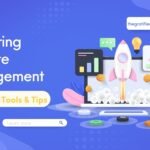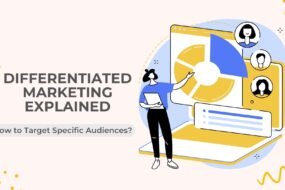
What do Dropbox, Airbnb, and Uber have in common? Besides, successful startups rely on Growth Marketing to optimize the user experience.
Growth Marketing is a strategic process that focuses on increasing the number of active users for a company’s product or service. It can be applied at any customer lifecycle stage, from acquisition to retention and loyalty.
In the forthcoming blog entry, we will delve into the core components of growth marketing and give examples of successful campaigns.
What Is Growth Marketing?
The term “Growth Marketing” is often used interchangeably with “user acquisition” or “customer acquisition.” However, Growth Marketing is about more than just acquiring new users; it’s about guiding them through a strategic growth marketing funnel.
This funnel encompasses a series of stages that involve attracting, converting, and retaining customers. It centers on building customer relationships and cultivating loyalty, ensuring customers become long-term, loyal advocates for your brand.
You can rapidly optimize your organization’s growth through many channels by building and delivering highly tailored, individualized messaging aligned to your customer’s needs at each stage.
Growth marketing has evolved past the “get-growth-quick” tactics of growth hacking but still embraces its testing, experimentation, and expansion roots. These principles are applied throughout the customer journey, ensuring that campaigns are constantly refined and improved.
Looking further down the funnel, growth marketing generates excellent customer retention and satisfaction rates. It’s not just about acquiring customers; it’s also about activating, retaining, and maximizing the value of these customers.
This end-to-end approach creates brand loyalty, customer awareness, and enough demand to secure long-term sales. It enables businesses to drive continuous growth and achieve sustainable success in today’s competitive landscape.
What Makes Growth Marketing Different?
Growth Marketing is different from traditional marketing in several ways.
- The growth marketers are focused on growth objectives such as increasing the number of active users.
- Growth marketers employ a method rooted in data analysis to pinpoint and track key metrics.
- Growth marketers are constantly experimenting with new growth strategies and tactics.
What Does Growth Marketing Mean?
Growth marketing is often used interchangeably with “user acquisition” or “customer acquisition.” Still, it is more than just acquiring new users.
It is also about retaining and engaging those users to become long-term, loyal customers. Growth marketing centers around cultivating customer relationships and nurturing loyalty, and it’s a long-term strategy where authenticity and engagement create excellent customer retention and satisfaction rates.
Growth marketing involves relentless experimentation and an intense focus on customers’ unique, changing motives and preferences. It has evolved past the “get-growth-quick” tactics of growth hacking and applies testing, experimentation, and expansion principles to campaigns throughout the customer journey.
Growth marketing is marketing 2.0, taking the traditional marketing model and adding Elements like A/B testing, value-enhancing blog posts, data-informed email marketing initiatives, SEO fine-tuning, imaginative ad copy, and comprehensive technical analysis contribute to optimizing every facet of a user’s journey.
Growth marketers constantly analyze data and feedback on what’s working and what isn’t, striving to comprehend the advantages that resonate with users and encourage continued engagement.
Growth marketing transforms the traditional “make a product, then market it” pathway into “make, then market, then analyze, then remake, then remarked. It is an essential part of its strategy, as it helps businesses build a loyal customer base that can drive revenue and growth.
Core Components Of A Growth Marketing Strategy
There are four core components of it:
A/B Testing
Marketing aims to effectively promote products or services to target audiences and generate conversions. A/B testing is crucial in achieving this goal by allowing marketers to gather data and make informed decisions.
By comparing different web pages or email campaign versions, marketers can determine which variation performs better in achieving their desired conversion goal. A/B testing eliminates the need for guesswork and helps shift business conversations from mere assumptions to concrete knowledge.
It empowers individuals, teams, and companies to make precise adjustments to their user experience, marketing strategies, and website optimization, ultimately boosting conversions. Therefore, A/B testing is an indispensable technique for marketers to evaluate and optimize their conversion funnel and overall marketing campaigns Revolution.

Source : static.wingify.com
Cross-Channel Marketing
Channel marketing plays a crucial role in cross-channel marketing strategies. It involves strategically utilizing various channels such as email, social media, paid ads, and more to reach and engage a wider audience.
You can establish a smoother and more interconnected customer journey by incorporating channel marketing into your cross-channel approach. Through channel marketing, marketers can leverage people-based marketing to gather comprehensive profiles of their target audience,
Allowing for personalized customer experiences and increased loyalty. With advanced solutions, organizations can optimize their cross-channel marketing efforts, leading to higher engagement, a more substantial brand presence, and valuable insights into customer behavior.
Also read: A Complete Guide To Channel Marketing

Source : www.sender.net
Customer Lifecycle
The customer lifecycle pertains to the path a customer takes from initial engagement to subsequent stages, from the moment they become aware of a product or service to the point of purchase and beyond. It comprises five stages: reach, acquisition, conversion, retention, and loyalty.
Marketing efforts aim to move customers through each lifecycle stage and convert them into loyal, long-term customers. The customer lifecycle is nonlinear and varies on a case-by-case basis.
Customer retention is the end goal of the customer lifecycle, and businesses need to continually offer relevant and timely messaging to prior customers to maintain top-of-mind awareness. The customer lifecycle can help enterprises maximize the revenue potential for each client who purchases on their website.
By analyzing and assessing their present performance, launching lifecycle marketing initiatives, and employing suitable tools to oversee each stage, businesses can take control of their customers’ lifecycles and create loyal customers.

Source: instapage.com
Examples Of Growth Marketing Campaigns
Now that we’ve covered the basics of Growth Marketing let’s look at some examples of successful marketing campaigns.
Loyalty
Focusing on customer loyalty can be an effective way to increase growth. One strategy is offering customers incentives to return, such as discounts or reward points. Another option is to create A rewards program enabling customers to accumulate points with each purchase.
This encourages customers to continue doing business with you and can increase sales and revenue. You can establish a dedicated customer foundation to consistently uphold your business by delivering exceptional customer service and establishing strong customer connections.
It is important to regularly evaluate and update your loyalty program to ensure that it meets your customers’ needs and provides value to your business.
Moreover, you can use customer feedback to enhance your product offerings and services and tailor your loyalty program to meet their needs better. Focusing on customer loyalty is an intelligent business strategy that can help drive growth and success.

Source : searchenginejournal.com
Referral Programs
A referral program is a strategy that can help increase the growth of a business. Referral programs allow customers to earn rewards for referring new customers to the company. This strategy is effective because it not only brings in new customers but also helps to retain existing ones. Referral programs are a type of loyalty program that can hook customers to the business.
They reward existing customers for referring friends, giving them another reason to stick with the business and reward the friends they refer for making their first purchase. Referral marketing is one of the best approaches, with different referral incentives. Influencer marketing is another excellent strategy for the referral stage.
Establish connections with influential figures on social media within your industry, collaborate with them, and leverage their audience to boost sign-ups and conversions. Referrals can be a game-changer for driving business growth.
Top Growth marketing strategies are centered around retention and keeping an eye on the business’s long-term success. Customer retention is vital for any business, and referral programs are a great way to focus on customer retention and referrals.

Source : cashlez.com
Onboarding
The onboarding process is a new customer’s initial step to get started with a product or service. Ensuring the onboarding process is simple and easy to follow is essential. This is possible through incentives, such as discounts, to encourage customers to complete the onboarding process.
The onboarding process is also essential for new employees as it helps them to quickly understand their role, their employer’s expectations, and the company’s culture. Employee onboarding is an extensive process lasting up to 12 months, providing new employees and Equipping individuals with the training, knowledge, and resources necessary for success in their new roles.
Onboarding allows new hires to acclimate with the company, fostering better employee engagement, job satisfaction, and excellent retention of new hires. Providing specific training on how to serve customers, even the difficult ones, is also essential. This can be done through Guidance, which can take the form of coaching, mentoring, on-the-job training, or job shadowing.
Training could involve a more organized approach, like instructional sessions that educate new hires on utilizing customer relationship management software and phone systems, addressing service breakdowns, and recovering service. It includes learning to deliver value to customers to foster long-term loyalty and mastering techniques for upselling or cross-selling that customers find valuable.
Learn about the company’s articulate vision, mission, and objectives, or oversee social media platforms for customer service and interaction. Onboarding is a human resources industry term for introducing a newly hired employee into an organization.
The process helps them integrate seamlessly with the rest of the company. Onboarding consists of multiple individual procedures, including job offers, salary negotiation, new hire paperwork, policy and culture training, job training, employee handbook training,
Benefits paperwork, benefits education, facility tours, executive introductions, and team introductions. It is essential to take the onboarding process online to ensure new employees can integrate into their new organizational roles.

Source : softwaresuggest.com
Growth Marketing Vs. Growth Hacking
Growth marketing agencies understand the importance of growth hacking and its strategies in today’s competitive landscape. They recognize that while growth hacking can provide immediate results, adopting a holistic growth marketing approach for long-term success is equally crucial.
These agencies leverage their expertise in data analysis, technology, and traditional marketing tactics to help businesses achieve sustainable growth. Combining revolutionary ideas with deeper research, they develop strategies encompassing the entire customer journey, from building brand awareness to nurturing customer loyalty.
These agencies not only focus on acquiring new customers but also on monetizing them over the long term. Whether start-ups seeking quick results or established businesses aiming for sustainable growth, it tailors their strategies to suit each client’s unique needs.
Important Goals & Measurements For A Growth Marketer
As a growth marketer, your primary objective is to propel business growth via strategic marketing endeavors. To achieve this goal, here are ten essential goals and measurements to consider:
Increase Customer Acquisition Is Crucial To Monitor A Range Of Growth Marketing Metrics Ton
To optimize its strategies and evaluate their impact on business expatriates.
One of the key metrics in this domain is the number of new customers acquired within a specific time frame, which provides insights into the effectiveness of marketing campaigns in attracting fresh users.
This metric is a fundamental indicator of success for analyzing a company’s efficiency and profitability.
By gauging the implications of this metric, businesses can effectively determine the return on investment associated with customer acquisition efforts.
Calculating this metric involves dividing the total expenses incurred for acquiring customers over a specific time by the number of customers; as a result, this offers a comprehensive perspective on growth marketing performance.
Improve Customer Retention
To save costs, track The proportion of customers maintaining ongoing engagement with your brand. Keeping customers current is frequently more budget-friendly than obtaining new ones.
Numerous businesses prioritize acquiring new customers over nurturing existing ones, often overlooking the equal significance of customer retention.
The success and expansion of your business hinge on the crucial role of customer retention marketing.
Boost Conversion Rates
Conversion rate measures the rate at which website visitors or leads convert into paying customers. Optimizing conversion rates is essential to maximize the effectiveness of marketing efforts.
Conversions can happen all over a website, and To optimize the potential for transforming website visitors into paying customers, each location should be optimized.
Improving conversion rates can yield a higher return on investment (ROI). Yet, it demands continuous effort and commitment to constantly fine-tuning and optimizing the website and marketing strategies.
By incorporating best practices in Conversion Rate Optimization (CRO), Businesses can enhance their marketing endeavors for increased effectiveness—the likelihood of turning website visitors into paying customers.
Reduce Customer Churn
To ensure customer retention and revenue generation, monitoring the rate customers discontinue their relationship with your brand is essential.
This can be done by setting clear benchmarks for when a customer is about to churn and actively tracking metrics to identify when reaching an unacceptable rate.
Gathering customer feedback and replying to third-party reviews can also help prevent churn. To reduce customer churn rate
Businesses can lean into their best customers, be proactive with communication, define a roadmap for new customers, offer incentives, and ask for feedback often.
Optimize Customer Acquisition Cost (CAC)
To improve profitability and efficiency in your marketing campaigns, it is essential to calculate the average cost of acquiring a new customer.
Lowering the customer acquisition cost (CAC) can help achieve this goal. There are several ways to reduce CAC, such as using the proper acquisition channels, deciding when to use paid and organic acquisition channels,
They identify high-value customers, optimize your funnel, and use marketing automation tools. By reducing CAC, businesses can increase their return on investment (ROI) and sustain growth.
- Increase Organic Traffic:
You can track your organic search traffic to quantify the visitors discovering your website via natural or organic search results. Growing organic traffic indicates effective search engine optimization (SEO) and content marketing strategies.
For most websites, organic search traffic is the primary source of visits. It plays a vital role in the buyer funnel, resulting in elevated conversions and a higher return on investment (ROI).
You can use metrics such as keyword ranking and organic click-through rate to track your organic traffic. Utilizing tools such as Google Search Console is also an option, and Semrush can measure your organic traffic and compare it to your competitors.
Enhance Brand Awareness
To evaluate brand awareness growth, assess the familiarity and establish brand recognition within the target audience. Use metrics such as social media mentions, brand sentiment, and reach to track progress.
Conduct brand awareness surveys regularly to gather insights into what customers think about your brand. Backlink profiles can also provide information about the popularity of your brand.
Use social media analytics to measure exposure and potential and identify the significant influencers in the industry to reach the audiences that matter. Finally, sentiment analysis is crucial to brand management when staging a brand awareness campaign.
Improve Lead Generation
Tracking the quantity and caliber of generated leads through various marketing channels is essential to fuel the sales pipeline and conversion process. Expanding the reach of lead generation efforts can help identify potential customers and increase the number of leads in the sales pipeline.
This saves time for the sales team and allows them to focus on high-value contacts. Lead generation can be enhanced through various strategies, such as content marketing.
Email marketing and creating campaigns with many touches across multiple channels. Quality is essential, so it is crucial to qualify leads to avoid spinning wheels.
Improve Customer Satisfaction
To ensure your marketing efforts align with customer expectations and enhance their overall experience, gauge customer satisfaction through surveys, feedback, and Net Promoter Score (NPS).
NPS measures customers’ loyalty to a company and is based on asking customers a question that predicts the likelihood of repurchasing and referring. The NPS question is, “How likely would you recommend this company to a friend or colleague?
Respondents rate their responses on a scale ranging from 0 to 10. SurveyMonkey Benchmarks provide context for your Net Promoter Score, with numerous companies employing our NPS template to gauge customer loyalty and enhance business results.
Conclusion
We appreciate your engagement with our growth marketing blog post. Our aim is to contribute to your understanding of growth marketing, fostering an improved comprehension of its potential effects on enhancing the user experience.
We trust that the insights shared have proven valuable in expanding your knowledge in this domain. Should you have any inquiries, do not hesitate to contact us. I appreciate your consideration!
Thanks for reading 🙂








No Comments